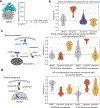Multi-input chemical control of protein dimerization for programming graded cellular responses
- PMID: 31501561
- PMCID: PMC6776690
- DOI: 10.1038/s41587-019-0242-8
Multi-input chemical control of protein dimerization for programming graded cellular responses
Abstract
Chemical and optogenetic methods for post-translationally controlling protein function have enabled modulation and engineering of cellular functions. However, most of these methods only confer single-input, single-output control. To increase the diversity of post-translational behaviors that can be programmed, we built a system based on a single protein receiver that can integrate multiple drug inputs, including approved therapeutics. Our system translates drug inputs into diverse outputs using a suite of engineered reader proteins to provide variable dimerization states of the receiver protein. We show that our single receiver protein architecture can be used to program a variety of cellular responses, including graded and proportional dual-output control of transcription and mammalian cell signaling. We apply our tools to titrate the competing activities of the Rac and Rho GTPases to control cell morphology. Our versatile tool set will enable researchers to post-translationally program mammalian cellular processes and to engineer cell therapies.
Conflict of interest statement
Competing interests
The authors G.W.F, Z.W., C.T.W., P.G., D.C-B., K.P., D.B., and D.J.M. are inventors on US Patent application 62/775,171, “Reagents and Methods for Controlling Protein Function and Interaction” submitted by University of Washington.
Figures




References
-
- Giorgetti L et al. Noncooperative interactions between transcription factors and clustered DNA binding sites enable graded transcriptional responses to environmental inputs. Mol Cell 37, 418–428 (2010). - PubMed
-
- Daniel R, Rubens JR, Sarpeshkar R & Lu TK Synthetic analog computation in living cells. Nature 497, 619–623 (2013). - PubMed
Publication types
MeSH terms
Substances
Grants and funding
LinkOut - more resources
Full Text Sources
Other Literature Sources
Research Materials
Miscellaneous

